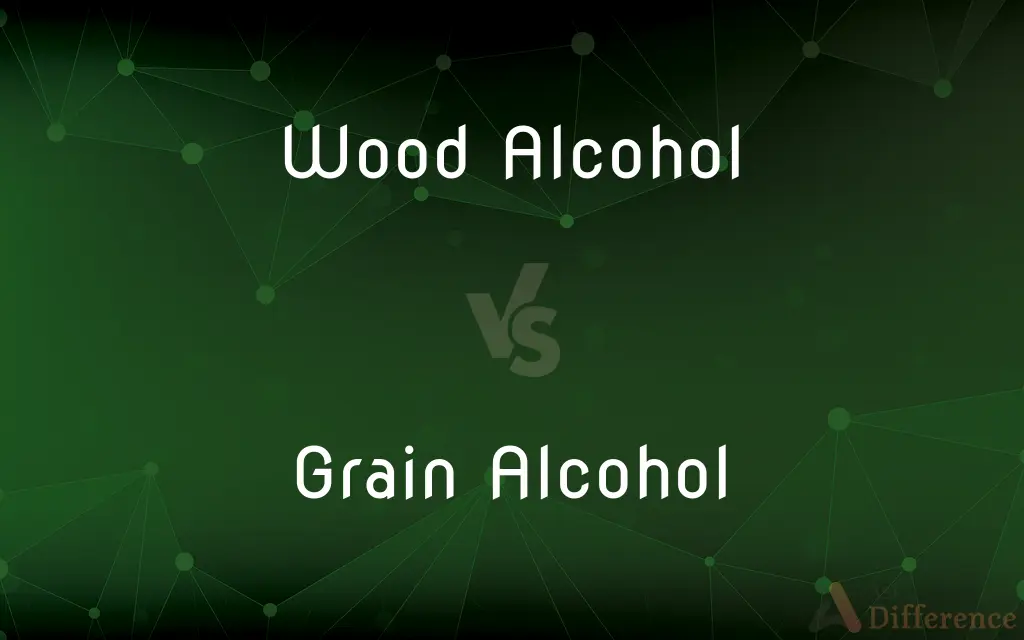Wood Alcohol vs. Grain Alcohol — What's the Difference?
By Tayyaba Rehman & Fiza Rafique — Published on September 14, 2024
Wood alcohol, or methanol, is a toxic solvent used industrially, while grain alcohol, or ethanol, is a consumable alcohol found in beverages.

Difference Between Wood Alcohol and Grain Alcohol
Table of Contents
ADVERTISEMENT
Key Differences
Wood alcohol, known scientifically as methanol, is primarily used as a solvent, antifreeze, or fuel. It is derived from the destructive distillation of wood and is toxic to humans, leading to serious health risks if ingested. Grain alcohol, or ethanol, is produced through the fermentation of grains and is the type of alcohol found in alcoholic beverages. It is safe for consumption in regulated amounts.
Methanol is characterized by its high toxicity, with ingestion leading to metabolic acidosis, vision problems, and potentially fatal outcomes. Ethanol, however, is metabolized by the body into less harmful compounds, although excessive consumption can lead to alcohol poisoning and long-term health issues.
The industrial uses of methanol extend to the production of formaldehyde, plastics, and other chemicals, highlighting its importance in manufacturing. Ethanol's versatility sees it used not only in beverages but also as a biofuel and in pharmaceuticals, showcasing its broader utility in both industrial and consumer products.
Methanol's lower boiling point compared to ethanol makes it valuable in specific industrial applications requiring quick evaporation. Ethanol's properties, including its ability to dissolve organic compounds and serve as a preservative, make it indispensable in food, medical, and cosmetic industries.
Both methanol and ethanol are used as solvents and fuels, but their applications are distinctly guided by their toxicity and impact on human health. Methanol serves in more industrial and less direct human contact applications, while ethanol's lower toxicity allows for a wide range of uses, including consumption and topical applications.
ADVERTISEMENT
Comparison Chart
Primary Use
Solvent, antifreeze, fuel
Beverages, solvent, biofuel
Toxicity
Highly toxic, not for consumption
Safe in regulated amounts
Source
Destructive distillation of wood
Fermentation of grains
Boiling Point
Lower than ethanol
Higher than methanol
Industrial Use
Formaldehyde, plastics production
Biofuel, pharmaceuticals, preservatives
Compare with Definitions
Wood Alcohol
Dangerous if ingested, leading to serious health issues.
Accidental ingestion of methanol can cause blindness.
Grain Alcohol
Acts as a disinfectant and antiseptic in medical settings.
Ethanol-based sanitizers are effective against bacteria and viruses.
Wood Alcohol
Employed as antifreeze in automotive products.
Methanol is added to windshield washer fluid for its antifreeze properties.
Grain Alcohol
Serves as a solvent in pharmaceuticals and cosmetics.
Ethanol is used to dissolve ingredients in cough syrups.
Wood Alcohol
A toxic solvent used in industrial applications.
Methanol is utilized as a solvent in paint strippers.
Grain Alcohol
Employed as a preservative in the food industry.
Ethanol is used in the preservation of some food products to extend shelf life.
Wood Alcohol
Acts as a fuel in specialized engines and racing applications.
High-performance vehicles sometimes use methanol fuel for its high energy content.
Grain Alcohol
Used as a biofuel and additive to gasoline.
Ethanol is blended with gasoline to produce E10 fuel.
Wood Alcohol
Used in the production of formaldehyde and plastics.
Methanol serves as a feedstock in the manufacture of adhesives.
Grain Alcohol
The type of alcohol suitable for consumption in beverages.
Ethanol is the active ingredient in beer, wine, and spirits.
Wood Alcohol
Alternative spelling of wood alcohol
Common Curiosities
What is the main difference between wood alcohol and grain alcohol?
Wood alcohol (methanol) is toxic and used industrially, whereas grain alcohol (ethanol) is consumable and found in beverages.
Can you drink wood alcohol?
No, drinking wood alcohol (methanol) is highly toxic and can be fatal.
Can ethanol be used to clean surfaces?
Yes, ethanol is an effective disinfectant for cleaning surfaces and killing bacteria and viruses.
Why is methanol toxic to humans?
Methanol is metabolized into formaldehyde and formic acid in the body, which are toxic and can cause metabolic disturbances and organ damage.
Is grain alcohol safe to consume?
Grain alcohol (ethanol) is safe to consume in regulated amounts found in alcoholic beverages.
What are the uses of methanol?
Methanol is used as a solvent, in antifreeze, as a fuel, and in the production of formaldehyde and plastics.
Can ethanol be used as a fuel?
Yes, ethanol is used as a biofuel and is added to gasoline to create a more environmentally friendly fuel option.
What happens if you ingest methanol?
Ingesting methanol can lead to metabolic acidosis, vision damage, and can be fatal without prompt treatment.
Is ethanol used in medical applications?
Yes, ethanol is used as a disinfectant, antiseptic, and solvent in various pharmaceuticals.
What precautions should be taken when handling methanol?
Use in a well-ventilated area, wear protective clothing, and avoid ingestion or prolonged skin contact to prevent poisoning.
Share Your Discovery

Previous Comparison
Condo vs. Duplex
Next Comparison
Direct Cylinder vs. Indirect CylinderAuthor Spotlight
Written by
Tayyaba RehmanTayyaba Rehman is a distinguished writer, currently serving as a primary contributor to askdifference.com. As a researcher in semantics and etymology, Tayyaba's passion for the complexity of languages and their distinctions has found a perfect home on the platform. Tayyaba delves into the intricacies of language, distinguishing between commonly confused words and phrases, thereby providing clarity for readers worldwide.
Co-written by
Fiza RafiqueFiza Rafique is a skilled content writer at AskDifference.com, where she meticulously refines and enhances written pieces. Drawing from her vast editorial expertise, Fiza ensures clarity, accuracy, and precision in every article. Passionate about language, she continually seeks to elevate the quality of content for readers worldwide.













































